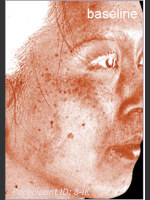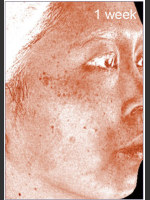Try The Lunch Break Facial: Why Microdermabrasion Treatments Make Sense

By Eileen Spatz
Microdermabrasion-that's a six-syllable mouthful of a term that you may have heard of, but weren't privy to what exactly it is. In a nutshell, this is where your Latin and Greek root word studies from yesteryear may help out: micro (Greek- very small) derm (Greek- skin) abrasion (Latin- scraping or rubbing of a spot or area (abrade)). In essence, microdermabrasion is the scraping of the skin using tiny crystals or diamond tip technology.
What?s Old is New Again
Before you exclaim, "What will they think of next?", understand that the concept of abrading the skin goes back to the ancient Egyptians who used sandpaper in 1500 B.C. to smooth out scars. A hundred years ago, Germans devised rotating wheels fitted with files that removed the top layers of skin. By the mid-'50s motor powered wire brushes became the norm (ouch!) to remove the top layer of skin. Finally, in 1985 an Italian manufacturer developed the current iteration of microdermabrasion using aluminum oxide crystals, introducing into the U.S. in 1995.
Exactly What Does Microdermabrasion Do?
Microdermabrasion is a safe, minimally invasive cosmetic procedure that utilizes a lightly abrasive instrument to exfoliate the skin, removing the top layer. This convenient procedure lasts only a half hour, requires no anesthesia, and is well tolerated with minimal discomfort.
When the outer layer of skin (the stratum corneum) is removed, the body responds by replacing the lost skin with fresh new skin cells, increasing collagen production. By sloughing off dull, dead surface layers of skin, the procedure stimulates lymph flow and blood flow, increasing nutrients to the skin cells. The cosmetic benefits of microdermabrasion are many, including:
- Improved elasticity
- Evens out skin tones
- Reduces age spots
- Enhanced circulation
- Reduces melasma pigmentation
- Brightens complexion with a healthy glow
- Reduces fine lines
- Reduces clogged pores and pore size
- Reduces mild acne scarring
Different Types of Microdermabrasion
Microdermabrasion comes in various forms, each with their own set of pros and cons. Selecting the type of microdermabrasion best suited for your particular skincare needs is important to the outcome. All types of microdermabrasion will process some redness and mild swelling on the skin, but this resolves within a day.
Crystal Microdermabrasion
Crystals made from nontoxic aluminum oxide (corundum) or organic sodium bicarbonate are delivered through a wand to the surface of the skin, exfoliating dead skin cells and polishing the skin. The material is then suctioned off immediately using the same handpiece. Crystal microdermabrasion is the preferred method for treating acne scars, as the loose crystals have a deeper reach and have antibacterial properties.
There are a few negatives about crystal microdermabrasion, which include the sense of the face being "sandblasted," a pink or red glow that lasts about a day, the crystals can be inhaled and that crystals may irritate the eyes.
Diamond Microdermabrasion
The diamond microdermabrasion uses a wand with a natural or synthetic diamond tip that abrades the skin, and also includes a suction or vacuum process to remove the debris. Diamond tip microdermabrasion is easier to control than crystal, with no risk of ingestion. This allows the treatment to access areas close to the eyes and mouth.
The negatives associated with diamond microdermabrasion include a concern that skin cells may build up on the wand itself, making it possible to spread bacteria to other areas of the face. Also, the diamond tip is not able to reach all the nooks and crannies that crystal microdermabrasion can.
DermaSweep
DermaSweep combines bristle tip exfoliation, increased circulation, and specific skincare product delivery. Clean paraben free skincare products range from growth factors to probiotics, peptides, chemical peels, antioxidants and hyaluronic acid.
The variety of bristle-tipped heads offer varying levels of coarseness to the abrading of the skin while decreasing irritation to the skin in treatment. DermaSweep bristle tips range from silk to nylon, to polyester. Not only do these tips exfoliate, but they also deliver the serums simultaneously to the skin during the treatment.
The vacuuming portion of the procedure is also different, in that it can be modified to suction or push on the skin with a reversible airflow feature. The sweep variety allows for more customization through the use of the various tips and airflow settings and is said to be a gentler, pain-free form of microdermabrasion.
In a series of treatment sessions, DermaSweep will reduce fine lines and wrinkles, minimize photo-damage, improve aging skin, and is comfortable on sensitive skin and around the eye area.
HydraFacialMD
The HydraFacial treatment utilizes a double uniquely designed vacuuming action to exfoliate dead skin cells and rid the skin of excess oil. When compared to other microdermabrasion treatments out there, there are a few things unique with the treatment. The machine deposits a medical-grade to aid with the removal of dead cells and debris. At the same time, it vacuums the skin surface with a silicone tip. Glycolic and salicylic acid is deposited onto the skin through the tip, the pore opening is widened, and the vacuum suction removes the refuse. Strong pressure isn?t used, rendering the process more gentle and pain-free.
Using a serum delivery system, HydraFacial is a multi-purpose type of dermabrasion technique that combines cleansing, exfoliating, and extracting the impurities and dead skin cells. Simultaneously, this technique adds moisturizing antioxidants, hyaluronic acid, and peptides to instantly leave skin looking clearer. With additional treatments, HydraFacial will reduce fine lines and wrinkles, minimize dark spots, and improve skin hydration.
Serum Infusions Coupled with Microdermabrasion
Once the skin?s surface has been treated with microdermabrasion, it is ripe for receiving nutrients that can further enhance the results. Serum infusions deliver these topical nutrients using an oxygen infusion device, enabling the serums to deeply penetrate the skin. Serums used in this manner include vitamin C serum, peptide serum, hyaluronic serum, and retinol serum. Following the serum infusions, patients can experience even better treatment results with LED light therapy.
How Long do the Effects of Microdermabrasion Last?
After the first session, the patient will notice a rosy, glowing appearance that will last for a few days. The improved appearance in fine lines, elasticity, and pigment will continue to improve over the course of treatments. For best results, it is recommended that patients receive five to twelve treatments spaced two to four weeks apart. Follow up maintenance treatments may be required occasionally after the initial treatment regimen is completed.
Microdermabrasion providers are not regulated. Spas may include microdermabrasion in their menu of treatment offerings, but the aesthetician performing the procedure may not be fully qualified. If you go this route, you should understand the training certifications of the treatment provider. To reduce risk or to combine various aesthetic treatments, it is best to contact a plastic surgeon or dermatologist to ensure the best, safest microdermabrasion outcome.


